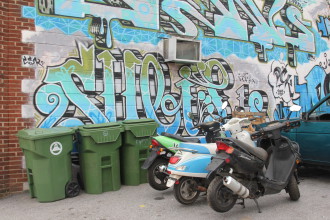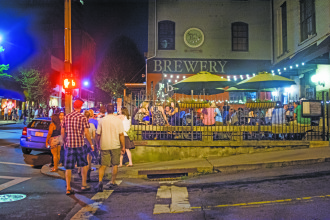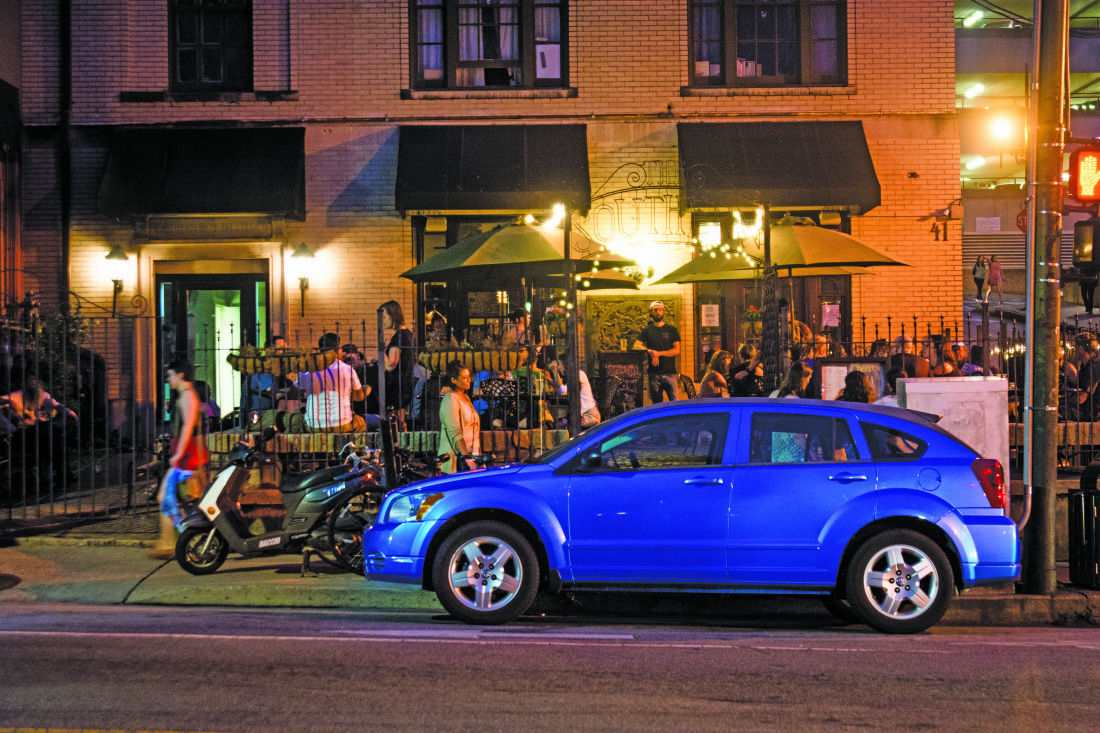It’s an overcast day interrupted by pockets of sun, walking a tightrope between melancholy and bliss. I’m standing on the sidewalk in front of The Scooter Doctor in West Asheville, which sells and services mopeds. Colloquially known as “liquor cycles,” mopeds are popular among folks who’ve lost their license due to a DWI charge.
State law defines mopeds as vehicles with two or three wheels, no external shifting device, an engine of up to 50 cubic centimeters, and a top speed of 30 miles per hour on a level surface. Due to changes that took effect July 1, however, North Carolina now treats mopeds the same as motorcycles, meaning the owner must get a title and tag for the vehicle. Beginning next July, they’ll also be required to carry liability insurance. Previously, anyone 16 or older who wore a motorcycle helmet could buzz down the state’s roadways on a moped as long as they didn’t go more than 30 mph.
Three men lean casually against the shop’s brick wall, watching mopeds whiz past with a high-pitched hum. From time to time the sun punches a hole through the dark cloud curtain, lighting up the shiny chrome bumpers on the line of scooters propped up along the sidewalk.
“This legislation just doesn’t make any sense,” declares Monroe Edgerton, a sturdy, confident, middle-aged man with a jovial demeanor, leaning up against his moped. “How can people that own scooters support their families if they can’t get to work because they can’t afford insurance? This is going to cause a whole lot of people to go hungry.”
Edgerton admits that he bought a moped after being charged with driving while impaired but says he’s since worked though his legal troubles. And though he now has a regular driver’s license, he says he can’t afford a car and the continued costs of owning one. He also voices his frustration with the city’s failure to extend mass transit hours despite the dramatic rise in the number of watering holes.
According to several websites, Asheville now boasts the highest number of breweries per capita of any U.S. city.
“We are not only Beer City: We are DWI City,” Edgerton declares.
None of the handful of bartenders I spoke with wanted to go on the record, though several said many of their friends had had DWIs. And it’s not the kind of thing a lot of people want to go public with, so finding folks to interview isn’t easy.
Driving while impaired is no laughing matter. Many people have lost family members that way or have suffered the bitter reality of hitting and killing someone themselves.
Blood alcohol concentration is the most common way North Carolina determines whether a driver is legally impaired, as follows:
- 21 or older: 0.08 percent
- commercial drivers: 0.04 percent
- under 21: any alcohol content
- prior DWI: 0.04 percent
The law also considers whether the driver’s physical or mental fitness is provably impaired by alcohol, drugs or a combination of the two.
So, given all of the above, just how difficult is it to enjoy a few libations in Beer City without waking up in your very own terrifying episode of “Orange is the New Black”?
Trolling taxis, fake IDs
To get a sense of this, I decide to drive downtown, get some drinks, observe the local bar culture and return home safely without

driving. Accordingly, on a recent Tuesday evening, I park in the top tier of the Rankin Avenue deck, drawn by its proximity to several bars and restaurants, the 24-hour security and a flat rate of $10 per day for vehicle storage. Armed with camera, notebook, pen, a phone and some cash, I walk down the hill toward The Southern Kitchen and Bar. I am greeted at the door and take a seat at the bar.
The knowledgeable bartender explains that several different taxi companies park right outside and wait on patrons in need of transportation. Just before 11 p.m., I glance outside and spot a Yellow Cab waiting out front with no passenger. Before I can set up a photo, however, it drives off with a bar patron inside, and a driver from the New Blue Bird Taxi Co. takes its place at the curb.
Tucked inside the cash register, the bartender reveals, is a stack of fake ID cards waiting to be turned over to the Alcohol Law Enforcement branch. State law prohibits serving anyone who’s believed to be underage or who might give an alcoholic beverage to someone underage, and patrons are carded both at the door and the bar.
Sorry, Charlie
I’m savoring a potato vodka, lychee, fresh lime and ginger martini when “Bob” (not his real name) sidles up to the bar, gently pulls out the stool and asks what I’m drinking. He appears to have control of his speech, eye contact and motor skills, and after listening politely, he orders a Mount Gay and soda with a slice of lime.
Bob polishes off the rest of my marinated olives along with his drink, and we stroll up the hill to 5 Walnut to peruse the wine list. During the short walk, he shows no visible signs of impairment. We each order a glass of sauvignon blanc and continue the conversation, enjoying the cool breeze coming in through the wide open windows.
As I finish my last sip, I’m seized with a sudden craving for the late night sliders made with local ground beef at the Rankin Vault Cocktail Lounge, directly across from the parking deck. Somehow, I can’t resist the thought of those palm-sized burgers topped with cheddar, spicy mayo, arugula and red onion, so we close our tabs and start our trek toward the Vault.
At this point, however, Bob undergoes a shocking, seemingly instantaneous transformation from showing no sign of impairment to looking as if his body had been taken over by a wobbly-legged teenage giraffe. While I continue my determined march toward those sliders (knowing full well that one merely leads to another), he careens back and forth across the sidewalk. And at the Vault, doorman Mitchell Keen tells Bob he won’t be allowed inside due to his spastic dance down the sidewalk.
Hard to gauge
Although bartenders must quickly decide whether someone’s too intoxicated to be served, there are often no visible signs of impairment, notes Andrew Mason, a forensic toxicologist with 40 years’ experience. “Part of the problem here is that for the vast majority of people, you have to obtain a blood alcohol content of between 0.1 and 0.15” to show signs of impairment — a level far higher than the legal limits.
Twelve ounces of a standard American lager has about the same alcohol content as a 5 ounce glass of wine or an ounce of liquor. But many factors affect how a person reacts to alcohol, including body weight, gender, whether they’re a habitual drinker, whether they’ve eaten and how quickly they’re drinking.
And meanwhile, all over Beer City, high-gravity beers are flowing out of taps and into 16 ounce glasses. That makes it even trickier for the average consumer to calculate how to stay below a 0.08 blood alcohol concentration. “The moment you have any alcohol in your body, it does affect your skills, and at the point a blood alcohol content of 0.08 is reached, you are already markedly impaired,” he says.
And though Mason notes that chronic drinkers can “throw off” alcohol faster than first-timers, he recommends erring on the side of caution. “When you’ve had a few drinks, go ahead and find methods of getting home safely, such as using [the online ride-hailing service] Uber, taxis, a designated driver or walking.” This, he continues, will “mitigate your risk to yourself and other individuals. Nobody is saying people shouldn’t drink, but people have to be responsible for their behavior.”
Sniffing out potential offenders

Once inside the Vault, I make a beeline for my late night holy grail of bar food.
Keen, meanwhile, explains that he watches people walk, checks for bloodshot eyes, looks for good eye contact and tries to detect the odor of alcohol. He also keeps an eye out for folks who may be digging around in trash cans looking for discarded cigarette butts.
When someone appears dangerously drunk, he often encourages them to sit down and drink water while he calls a cab. Before moving over to the Vault, Keen worked the door at Wicked Weed, which he says may deploy six door guys on weekend nights. “Alcohol Law Enforcement goes undercover, and we really have to be one our game,” Keen reveals. “People will buy a beer and set it down, and the ALE officers see how long it takes for us to pick it up.”
Three sliders and a trinity of vodka sodas later, I’m ready to slip home and drop into the type of dreamland that comes on the heels of late night grease and a liberal supply of libations. But though I’ve already committed to getting home without driving, I have no concrete plan. Keen, who has several taxis on speed dial, says that on average, cabs that aren’t already waiting out front take only 10 to 15 minutes to arrive. The bartender on duty echoes Mason in recommending Uber, saying it has significantly lowered the DWI rate in the city. Launched in 2010, the app enables users to “request, ride and pay via your mobile phone,” according to the website.
Oops…
Being somewhat technically challenged, however, I put in a call to Asheville Taxi requesting a cab at 2:15 a.m. But after receiving a text that my ride is right around the corner, I watch taxi lights fly past and assume that I’ve just missed my chariot. Undaunted, I step out onto the sidewalk and calmly wave, imagining myself as a seasoned New Yorker hailing a cab en route to a grand dinner at the Waldorf Astoria. It works! A taxi pulls up and I crawl in, impressed by my ability flag one down on the streets of a little big city that’s grown way beyond the boarded-up storefronts and empty streets of the Asheville I first met and fell in love with back in 1994.
As I bask in the glow of the driver’s dueling GPS screens, however, I get another text. It’s 2:11 a.m., and the message reads, “This is Kendra from Asheville Taxi. I’ll be there in about 10 minutes. I’m driving a light blue van.” My gloat melts into guilt as I realized I’ve hopped in a taxi that was randomly circling the block, trolling for fares.
“What taxi service is this?” I ask the driver.
“Don’t worry about it,” she replies, unconcerned. “It happens all the time. There are so many of us out here people get confused.”
As I slump back into my seat and watch the lights of Beer City stream past, I feel as if I’m balancing on an emotional tightrope, alternately missing the Asheville full of hope and expectation that I remember from my teenage years, and appreciating the more sophisticated city that I know today, with all the aches and pains inherent in growth.




Dear Sarah,
I find this article sensational, poorly researched and inaccurate.
Sensational, because you are trying to make a bad name for the brewers and their products by writing an article and mentioning multiple times the phrase ‘high gravity beer’ to get people to read your article on DWI.
Poorly researched. You are obviously not a beer drinker and you yourself drank four spirit drinks and a glass of wine, you didn’t drink beer, so how do you know what the effects are ?
Inaccurate. They do not pour high gravity beer ‘all over the city’ in 16 ounce glasses, they pour them in 8 or 10 ounce glasses, because they know their beer is higher than normal, but it is not spirit level or even wine level, and they always advise their patrons that the beer is higher. They put this on all their menus so a person can know exactly what they are ordering.
What was the percentage of alcohol for your vodka? Or is that not important to a spirit drinker.
Yes the article was on , can you get home after drinking irresponsibly in Asheville, and the answer was yes, very easily.
So, the article should have been titled ‘Drinking in Asheville and how to get home’, it has nothing to do with ridiculous ATD chosen title of Beer City, or high gravity beers.
Well said, Helen. This article is awful.
This article lacks data, was poorly researched and should never have been published. The anecdotal lead about scooters went on for too long, and the informal survey of anonymous bartenders was highly unprofessional.
Thankyou Stepfanie for your comment as well.. I absolutely love the New York Times Sunday edition and the narrative leads on the hard news stories. Perhaps if my narrative leads were a little stronger they would make more connection with the body of the story. This was my first story back with the X press in fourteen years, and I am just so thankful that you read the piece, and gave feedback. Thankyou so much for reading! Sarah Adeline Harnden
Dear Helen,
Thankyou so much for reading and responding. So few newspapers or online publications are being read anymore……it is flattering that you read the whole article and also thought about the piece and suggested improvements in the content. I would like to do a follow up story with more statistical data. After graduating from the University of North Carolina at Asheville, with great support from a Pulitzer prize winning journalism professor, Cathy Mitchell, I went out into the world and actually worked as a fulltime writer/photograher for a small town rag. I earned, after taxes, $366 dollars per week. But I loved the work, and even though I struggled financially, my passion is writing and shooting. The story you so kindly read (THANKYOU), was a difficult piece for me to write due some personal details that I cannot release at this time. Also, I produced it while running a restuarant, shooting weddings, and running a few other side businesses. I tackled it from a different angle, I got up and got out and had an experience and wrote a first person news lead, which is a unique for the mtn xpress. And Kudos to the Mtn X for thinking outside the box, and going out on a limb to publish something a little different than straight news packed with statistics. And I actually did a heck of alot of research, tracking down court reporters, toxicologist, bartenders, cops, and folks that have DWIs…..it was a hard one as no one seems to want to go on record. Thankyou so much for your feedback, as I really do think a followup story is in order. – Sarah Adeline Harnden
Dear Helen,
I also want to thankyou for you interest in whether or not I drink beer! My dad starting brewing beer in our basement in the late sixties, early seventies. I was born in the late sixties, so did’nt start drinking beer right away, but at some undisclosed point in time, I most certainly started drinking dads’ wonderful homebrew! I also worked as head bartender at the fabulous and elegant Carolina Inn on the campus of University of North Carolina for four years, and we had Chimay Tripel on draft, and it was super tasty. Once again, thankyou so much for reading. Cheers to Beer, Sarah Adeline Harnden
sarah,
i enjoyed the article and would like to read more of your stuff~i have been searching for a way to get ahold of you but have not succeeded~hope this works~